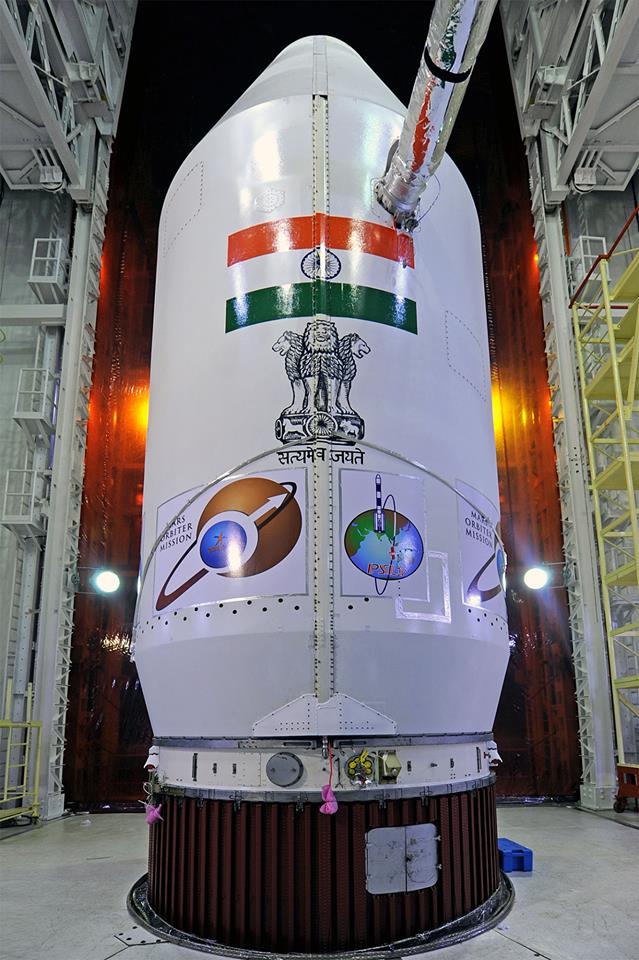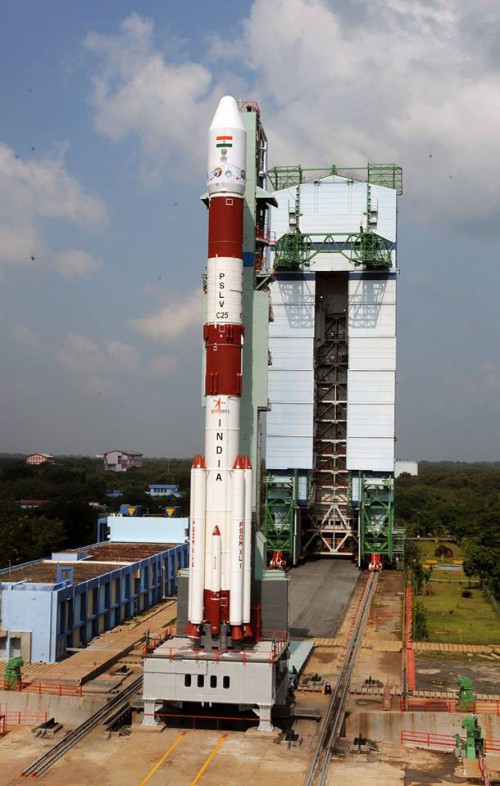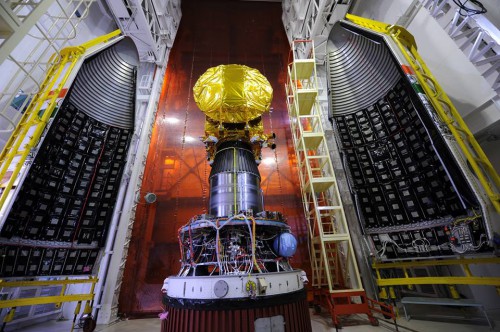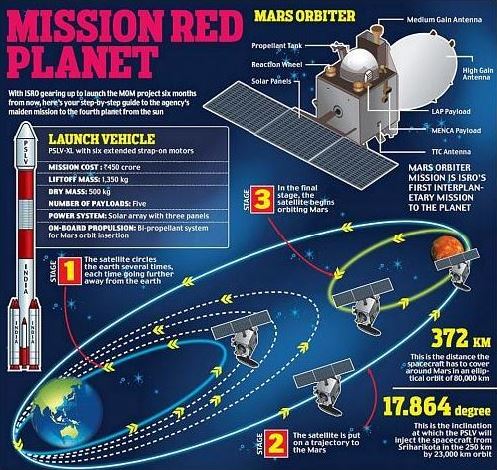
The Indian Space Research Organisation (ISRO) began a 56.5-hour countdown to the launch of its first mission to Mars on Sunday, 3 November, with the loading of propellants aboard the Polar Satellite Launch Vehicle (PSLV) nearing completion. Fueling of the fourth stage and the Reaction Control Thrusters (RCT) took place Sunday and preparations to fuel the second stage commenced earlier today (Monday, 4 November). Following a successful Launch Rehearsal last week, the Launch Authorisation Board issued a unanimous go-ahead to proceed toward a liftoff on the afternoon of Tuesday, 5 November. The Mars Orbiter Mission (MOM)—also known as “Mangalyaan” (Hindi for “Mars Craft”)—is due to reach the Red Planet in September 2014, where it will spend at least six months conducting scientific observations from orbit. The countdown formally commenced at 6:08 a.m. IST yesterday (Sunday), with ISRO tracking an opening launch attempt at 2:38 p.m. IST (4:08 a.m. EST) Tuesday.
Yesterday’s preparations occurred at the Satish Dhawan Space Centre, on the barrier island of Sriharikota, within India’s southern province of Andhra Pradesh, where the four-stage PSLV—which will fly in its extended “XL” configuration—has patiently weathered several delays. Originally targeted to fly on 28 October, the Launch Authorisation Board called for a postponement, partly due to poor weather in the South Pacific, which delayed the arrival of a critical ISRO tracking ship in the Fijian port of Suva. Two ships, the Marine Vessels (MV) SCI Nalanda and Yamuna, both provided by the Shipping Corporation of India, will monitor the ignition of the PSLV’s fourth stage and the insertion of the MOM/Mangalyaan payload into space, which is expected to occur high above the South Pacific.
Following the beginning of countdown operations, the fueling of the PSLV’s fourth stage and its reaction control thrusters with monomethyl hydrazine (MMH) and mixed oxides of nitrogen (MON) got underway and was completed late Sunday. Standing 144 feet (44 meters) tall, the rocket has the potential to deliver payloads weighing up to 7,160 pounds (3,250 kg) into low-Earth orbit and up to 3,100 pounds (1,410 kg) into geostationary transfer orbit and is therefore ideally suited to boost the fully-fueled 2,980-pound (1,350-kg) MOM/Mangalyaan spacecraft aloft. First flown in September 1993, the PSLV has completed 24 missions, of which one—ironically its maiden voyage—suffered an attitude-control failure during the separation of its second and third stages, crashing into the Bay of Bengal 700 seconds after liftoff. Another experienced an underperformance of its fourth stage during a September 1997 launch, but all other flights have been virtually flawless.

MOM/Mangalyaan will ride the uprated PSLV-XL, which made its inaugural flight back in October 2008, carrying Chandrayaan-1, India’s first spacecraft to visit the Moon. The vehicle will be powered for the first portion of its flight by a single first-stage engine and six strap-on boosters, all of which utilize a solid fuel of hydroxyl-terminated polybutadiene. Although the boosters will burn for just 44 seconds, the first stage will continue to drive the PSLV-XL uphill for the first 4.5 minutes of the mission. The second stage and its Vikas liquid-fueled engine will take over for 2.5 minutes, followed by the solid-fueled third stage for 83 seconds and lastly the twin liquid-fueled motors of the fourth stage for a little over 7 minutes. According to debris and trajectory maps published by NASASpaceflight.com, the PSLV’s first two stages and the strap-on boosters will impact the western Bay of Bengal after being jettisoned. The third stage will splash down in the central Andaman Sea, far to the east of the Andaman and Nicobar Islands, with the fourth stage propelling the vehicle out over the Pacific Ocean. Its impact footprint is anticipated to fall within a virtually uninhabited stretch of the South Pacific, to the west of Ecuador and Peru.
Throughout its history, variants of the PSLV have delivered payloads into orbit on behalf of India, Germany, South Korea, Norway, Italy, Luxembourg, Indonesia, Argentina, Israel, Canada, Japan, the Netherlands, Denmark, Switzerland, Turkey, Algeria, Singapore, Russia, Austria, the United Kingdom, and France. On its most recent launch, on 1 July 2013, it successfully delivered the IRNSS-1A payload into orbit for the Indian Regional Navigational Satellite System.
“After satellite separation from the launch vehicle,” explained ISRO on its Facebook page for the mission, “the Spacecraft operations are controlled from the Spacecraft Control Centre of ISRO Telemetry, Tracking and Command Network (ISTRAC) in Bangalore.” The spacecraft will execute a series of six firings of its Liquid Apogee Motor (LAM) to expand its orbit to an apogee of 133,600 miles (215,000 km) and a perigee of 370 miles (600 km). “The spacecraft leaves Earth in a direction tangential to Earth’s orbit,” explained ISRO’s official brochure for the mission, describing its Hohmann transfer ellipse, “and encounters Mars tangentially to its orbit,” noting that these opportunities to reach the Red Planet under conditions of the best economy of propellant expenditure, mission duration, and trajectory design arise approximately every 780 days. “Minimum-energy opportunities for Earth-Mars,” ISRO added, “occur in November 2013, January 2016, May 2018, etc.” MOM/Mangalyaan will occupy a highly elliptical Earth orbit for almost a month, ahead of a final LAM burn to inject it onto a trans-Mars trajectory. It will then cruise through interplanetary space for about 10 months.
“The spacecraft arrives at the Mars Sphere of Influence in a hyperbolic trajectory,” explained ISRO. “At the time the spacecraft reaches the Closest Approach to Mars (periapsis), it is captured into planned orbit around Mars by impacting delta-V retro, which is called the Mars Orbit Insertion (MOI) manoeuvre.” According to current mission plans, and assuming an on-time liftoff, MOI is anticipated at 2:34 a.m. IST on 24 September 2014 (5:04 p.m. EDT on 23 September), and MOM/Mangalyaan will enter an orbit of 310 x 50,000 miles (500 x 80,000 km), inclined 150 degrees. In this highly elliptical orbit, the spacecraft will circle the planet once every 76.72 hours. Quoting ISRO officials, FirstPost India noted that the minimum life of MOM/Mangalyaan in Mars orbit is six months, but hopes are high that it will exceed this target.

This mission is both highly ambitious and highly unlikely for the world’s second most populous nation, and its merits and motivations have triggered considerable debate. It is described as “a technology demonstration project,” and its primary task is to prove that India can design, plan, manage, launch, and operate a deep-space mission across the enormous gulf to reach the Red Planet. Equipped with five scientific instruments—the Methane Sensor for Mars (MSM), Mars Colour Camera (MCC), Mars Exospheric Neutral Composition Analyser (MENCA), Thermal Infrared Spectrometer (TIR), and Lyman-Alpha Photometer (LAP)—the MOM/Mangalyaan spacecraft is dedicated to developing a better understanding of the morphology, topography, and mineralogy of the Martian surface, together with the dynamics of its thin upper atmosphere, its loss of water, the influence of solar wind and radiation, and the nature of its moons, Phobos and Deimos. According to ISRO, the payloads were chosen by the Advisory Committee on Space Sciences (ADCOS).
Hopes are high for MOM/Mangalyaan, as India sets out on a path to become the fourth discrete organization, nation, or group of nations to successfully send its own mission to Mars. Only Russia, the United States, and the member states of the European Space Agency (ESA) have accomplished this feat to date. Yet the stakes are even higher, particularly in the wake of the ignominious failure of Russia’s Fobos-Grunt and China’s Yinghuo-1 spacecraft, which failed to leave Earth orbit in November 2011 and burned up in the atmosphere a few weeks later. “For Mars, there were 51 missions so far the world around,” ISRO Chairman Dr. K. Radhakrishnan told India’s Economic Times last week, “and there were 21 successful missions. It’s a complex mission.” He pointed out that the difference between success and failure in any space enterprise “is very, very thin,” but stressed that even a failure provides a stepping stone to success. Coming less than two years after the Fobos-Grunt and Yinghuo-1 failure, Dr. Radhakrishnan denied overt competition with China and scoffed at the notion of a “race” to Mars between the two nations. “We are in competition with ourselves,” he said, “in the areas that we have charted for ourselves. Each country has its own priorities.”
Dr. Radhakrishnan has admitted that the MOM/Mangalyaan mission will be a challenge, an opportunity, and a matter of national pride, and certainly illustrates the growing maturity of India’s space program. “Such scientific missions post very tough challenges to technologists,” he said. “Some of the outcomes—for example, the in-built autonomy we are providing in this spacecraft—can become a reality as a product or system and be used in satellites to improve their efficiency. So they percolate to application, which is our main objective. It could be something like forecasting cyclones. There is always relevance for a mission such as this.”

The spacecraft’s in-built autonomy has been incorporated in response to a recognition that the maximum Earth-Mars Round Trip Light Time (RLT) will be 42 minutes, making it “impractical to micromanage the mission from Earth with ground intervention.” As a consequence, MOM/Mangalyaan adopts autonomous Fault Detection, Isolation, and Reconfiguration (FDIR) logic, none of whose actions will disrupt the spacecraft’s Earth Pointing Attitude. ISRO considers this system to be essential during any communications problems or interruptions—during eclipses, for example—and it will safeguard the spacecraft during its insertion into Martian orbit.
Conditions in interplanetary space and in orbit around the Red Planet have also been simulated during numerous ground tests. The performance characteristics of the critical Liquid Apogee Motor have been evaluated in ISRO’s High Altitude Test Facility, whilst thermal balance tests have yielded baseline data for Mars radiation flux and have helped to validate thermal models. In order to handle the frigid cold of a Martian eclipse, MOM/Mangalyaan solar array “coupons” have been subjected to temperature conditions as low as -200 degrees Celsius, qualifying both the cells and their bonding agents. The spacecraft’s communications system has been exhaustively tested and verified by both ISRO and NASA’s Jet Propulsion Laboratory (JPL) of Pasadena, Calif., whose Deep Space Network (DSN) will work alongside the Indian Deep Space Network (IDSN) in tracking MOM/Mangalyaan. These tests have demonstrated “communications management” at the predicted distance between Earth and Mars at the point of MOI, an estimated 133 million miles (214 million km), and after six months in orbit, an estimated 233 million miles (375 million km).
Much criticism has been leveled at India in recent weeks, with some observers expressing open condemnation that ISRO is executing such a mission when it has pressing problems at home. The process of reconstruction in the wake of Cyclone Phailin’s ravages is still underway, and last year’s droughts, coupled with endemic poverty in the country, are both noteworthy and worrisome. Yet questions of the wisdom of “wasting” money on a space program have been asked time and again throughout history. Some have argued that space exploration, by its very nature, plays a key role in advancing a nation in a technological sense and helping to position its people onto the world stage. Last year, an Indian government official told the BBC that “if we don’t dare dream big, it would just leave us as hewers of wood and drawers of water.” Whatever our individual perspectives might be, on the eve of India’s first voyage to Mars we can be certain of one thing: that these hewers and wood and drawers of water have collectively accomplished something quite remarkable.
Want to keep up-to-date with all things space? Be sure to “Like” AmericaSpace on Facebook and follow us on Twitter: @AmericaSpace
Missions » MOM »



Best luck ISRO…..
Godspeed MOM.
That’s human race,Always greedy to seek knowledge…when will a man touch the mars?…Anyway i am 22 now,hope i will be here in this world….can’t wait..:}
cheap sale Direct Manufacturer cheap Canada Goose Cheap discount up to 60%.
cheap volleyball jerseys 1408 http://gocustomcase.com/?p=cheap-volleyball-jerseys-1408.html